Tube Archivist is a self hosted solution to download and privately watch your favorite subscriptions and YouTube channels without any ads. With Tube Archivist you can run your self hosted YouTube media server on your Synology NAS. In this step by step guide I will show you how to install Tube Archivist on your Synology NAS using Docker.
This guide works perfectly with the latest Tube Archivist v0.4.10 release.
STEP 1
Please Support My work by Making a Donation.
STEP 2
Install Portainer using my step by step guide. If you already have Portainer installed on your Synology NAS, skip this STEP. Attention: Make sure you have installed the latest Portainer version.
STEP 3
Make sure you have a synology.me Wildcard Certificate. Follow my guide to get a Wildcard Certificate. If you already have a synology.me Wildcard certificate, skip this STEP.
STEP 4
Go to Control Panel / Login Portal / Advanced Tab / click Reverse Proxy. Follow the instructions in the image below.

STEP 5
Now click the “Create” button. Follow the instructions in the image below.
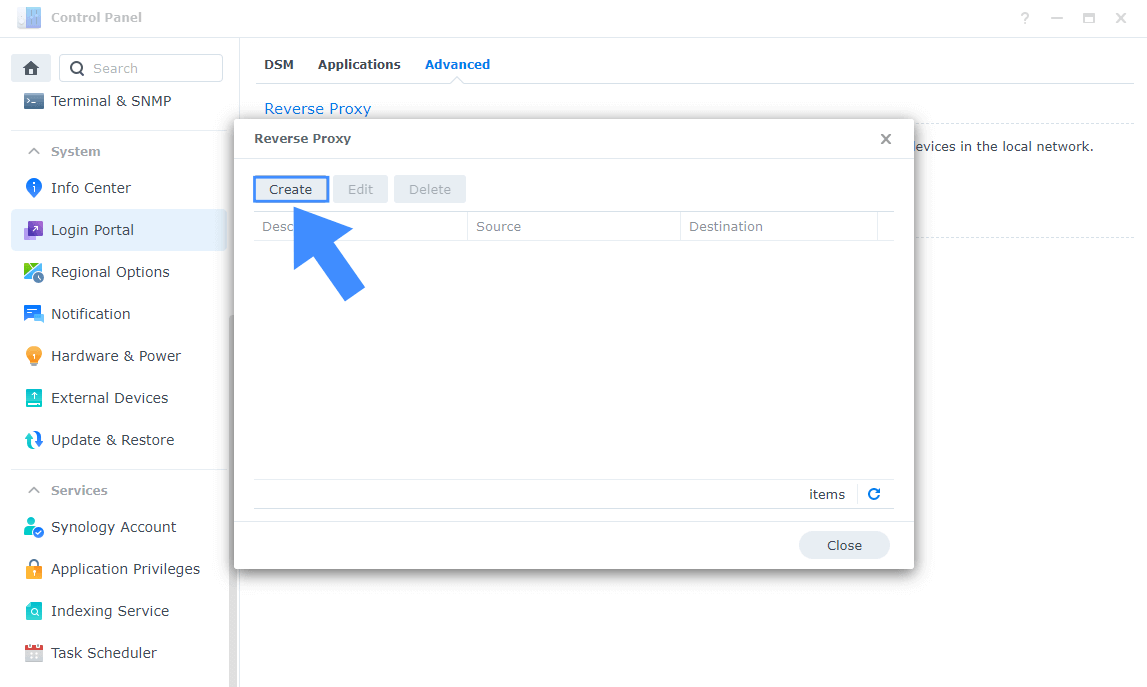
STEP 6
After you click the Create button, the window below will open. Follow the instructions in the image below.
On the General area, set the Reverse Proxy Name description: type in TubeArchivist. After that, add the following instructions:
Source:
Protocol: HTTPS
Hostname: tubearchivist.yourname.synology.me
Port: 443
Check Enable HSTS
Destination:
Protocol: HTTP
Hostname: localhost
Port: 8770
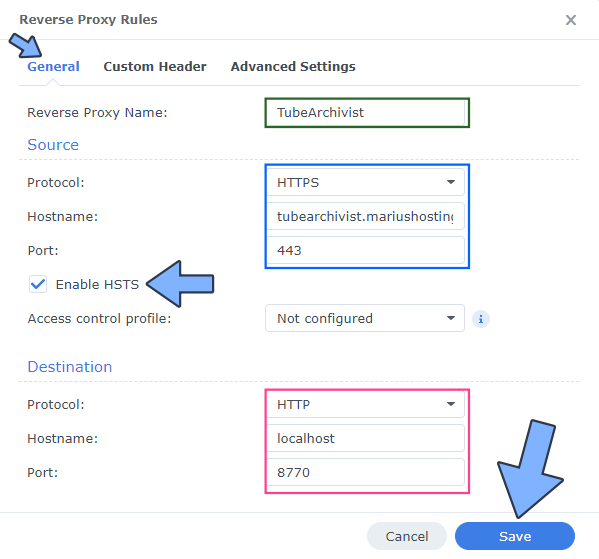
STEP 7
On the Reverse Proxy Rules click the Custom Header tab. Click Create and then, from the drop-down menu, click WebSocket. After you click on WebSocket, two Header Names and two Values will be automatically added. Click Save. Follow the instructions in the image below.

STEP 8
Go to Control Panel / Network / Connectivity tab/ Check Enable HTTP/2 then click Apply. Follow the instructions in the image below.

STEP 9
Go to Control Panel / Security / Advanced tab/ Check Enable HTTP Compression then click Apply. Follow the instructions in the image below.
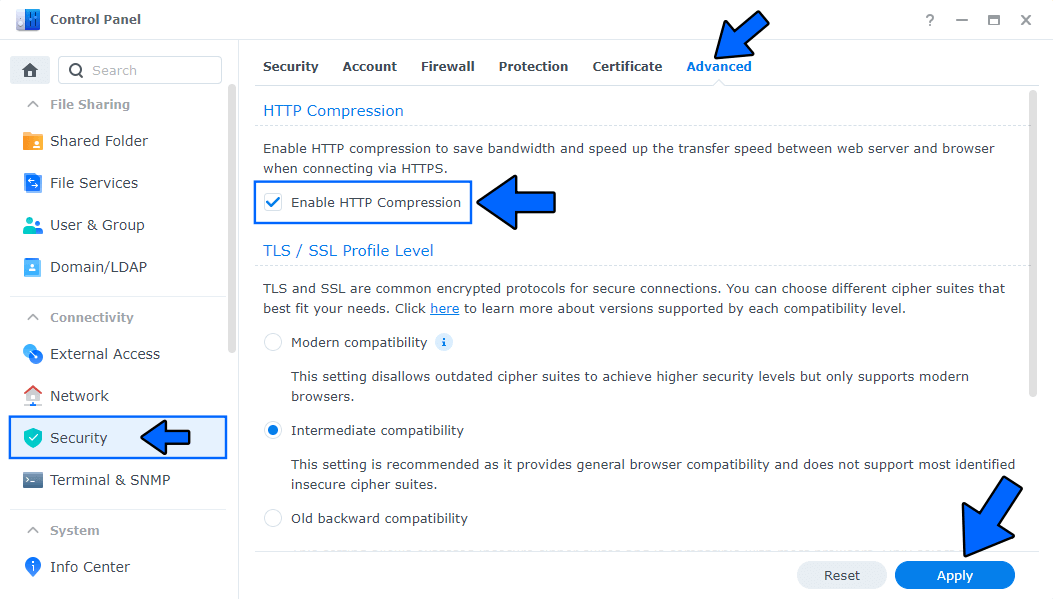
STEP 10
Go to File Station and open the docker folder. Inside the docker folder, create one new folder and name it tubearchivist. Follow the instructions in the image below.
Note: Be careful to enter only lowercase, not uppercase letters.

STEP 11
Now create four new folders inside the tubearchivist folder that you created at STEP 10 and name them cache, es, media, redis. Follow the instructions in the image below.
Note: Be careful to enter only lowercase, not uppercase letters.

STEP 12
Right click on the es folder that you have previously created at STEP 11 then click Properties. Follow the instructions in the image below.

STEP 13
Go to the Permission tab then click Advanced options. From the drop-down menu choose “Make inherited permissions explicit“. Follow the instructions in the image below.

STEP 14
Select Everyone then click the Edit tab. Follow the instructions in the image below.

STEP 15
Check all Read and Write Permissions. Click Done. Follow the instructions in the image below.

STEP 16
After you click Done on STEP 15, check “Apply to this folder, sub-folders and files“. Click Save. Follow the instructions in the image below.

STEP 17
Log into Portainer using your username and password. On the left sidebar in Portainer, click on Stacks then + Add stack. Follow the instructions in the image below.

STEP 18
In the Name field type in tubearchivist. Follow the instructions in the image below.
version: "3.9"
services:
es:
image: bbilly1/tubearchivist-es:latest
container_name: TubeArchivist-ES
hostname: tubearchivist-es
ulimits:
memlock:
soft: -1
hard: -1
security_opt:
- no-new-privileges:true
healthcheck:
test: curl -s http://tubearchivist-es:9200 >/dev/null || exit 1
environment:
- TZ=Europe/Bucharest
- ELASTIC_PASSWORD=tubearchivistpass
- ES_JAVA_OPTS=-Xms512m -Xmx512m
- xpack.security.enabled=true
- discovery.type=single-node
- path.repo=/usr/share/elasticsearch/data/snapshot
volumes:
- /volume1/docker/tubearchivist/es:/usr/share/elasticsearch/data
restart: always
redis:
image: redis/redis-stack-server
container_name: TubeArchivist-REDIS
hostname: tubearchivist-redis
security_opt:
- no-new-privileges:true
healthcheck:
test: ["CMD-SHELL", "redis-cli ping || exit 1"]
user: 1026:100
environment:
- TZ=Europe/Bucharest
volumes:
- /volume1/docker/tubearchivist/redis:/data
restart: always
depends_on:
es:
condition: service_started
tubearchivist:
image: bbilly1/tubearchivist:latest
container_name: TubeArchivist
hostname: tubearchivist
security_opt:
- no-new-privileges:true
ports:
- 8770:8000
environment:
- TZ=Europe/Bucharest
- HOST_UID=1026
- HOST_GID=100
- ES_URL=http://tubearchivist-es:9200
- REDIS_HOST=tubearchivist-redis
- TA_HOST=tubearchivist.yourname.synology.me
- TA_USERNAME=marius
- TA_PASSWORD=mariushosting
- ELASTIC_PASSWORD=tubearchivistpass
volumes:
- /volume1/docker/tubearchivist/media:/youtube
- /volume1/docker/tubearchivist/cache:/cache
restart: always
depends_on:
es:
condition: service_started
redis:
condition: service_healthy
Note: Before you paste the code above in the Web editor area below, change the value for TZ. (Select your current Time Zone from this list.)
Note: Before you paste the code above in the Web editor area below, change the value numbers for user with your own UID and GID values. (Follow my step by step guide on how to do this.) 1026 is my personal UID value and 100 is my personal GID value. You have to type in your own values.
Note: Before you paste the code above in the Web editor area below, change the value numbers for HOST_UID and HOST_GID with your own values. (Follow my step by step guide on how to do this.) 1026 is my personal HOST_UID value and 100 is my personal HOST_GID value. You have to type in your own values.
Note: Before you paste the code above in the Web editor area below, change the value for TA_HOST and type in your own synology.me DDNS that you have previously created at STEP 6.
Note: Before you paste the code above in the Web editor area, change the value for TA_USERNAME and add your own username. marius is an example for a username. You have to insert your own username.
Note: Before you paste the code above in the Web editor area, change the value for TA_PASSWORD and add your own password. mariushosting is an example for a password. You have to insert your own password.

STEP 19
Scroll down on the page until you see a button named Deploy the stack. Click on it. Follow the instructions in the image below. The installation process can take up to a few minutes. It will depend on your Internet speed connection.

STEP 20
If everything goes right, you will see the following message at the top right of your screen: “Success Stack successfully deployed“.

STEP 21
Go back to STEP 1 or you will deal with karma 🙂.
STEP 22
Please wait approximately 2 minutes for the installation to be completed or you will get a Synology blank page if you try to connect too soon. Now open your browser and type in your HTTPS/SSL certificate like this https://tubearchivist.yourname.synology.me In my case it’s https://tubearchivist.mariushosting.synology.me If everything goes right, you will see the Tube Archivist Login page. Type in your own Username and Password that you have previously created at STEP 18, then click Login. Follow the instructions in the image below.

STEP 23
Click Playlist. Follow the instructions in the image below.

STEP 24
Click +. Follow the instructions in the image below.

STEP 25
In the apposite area type in your favorite YouTube channel URL then click Subscribe. Follow the instructions in the image below.
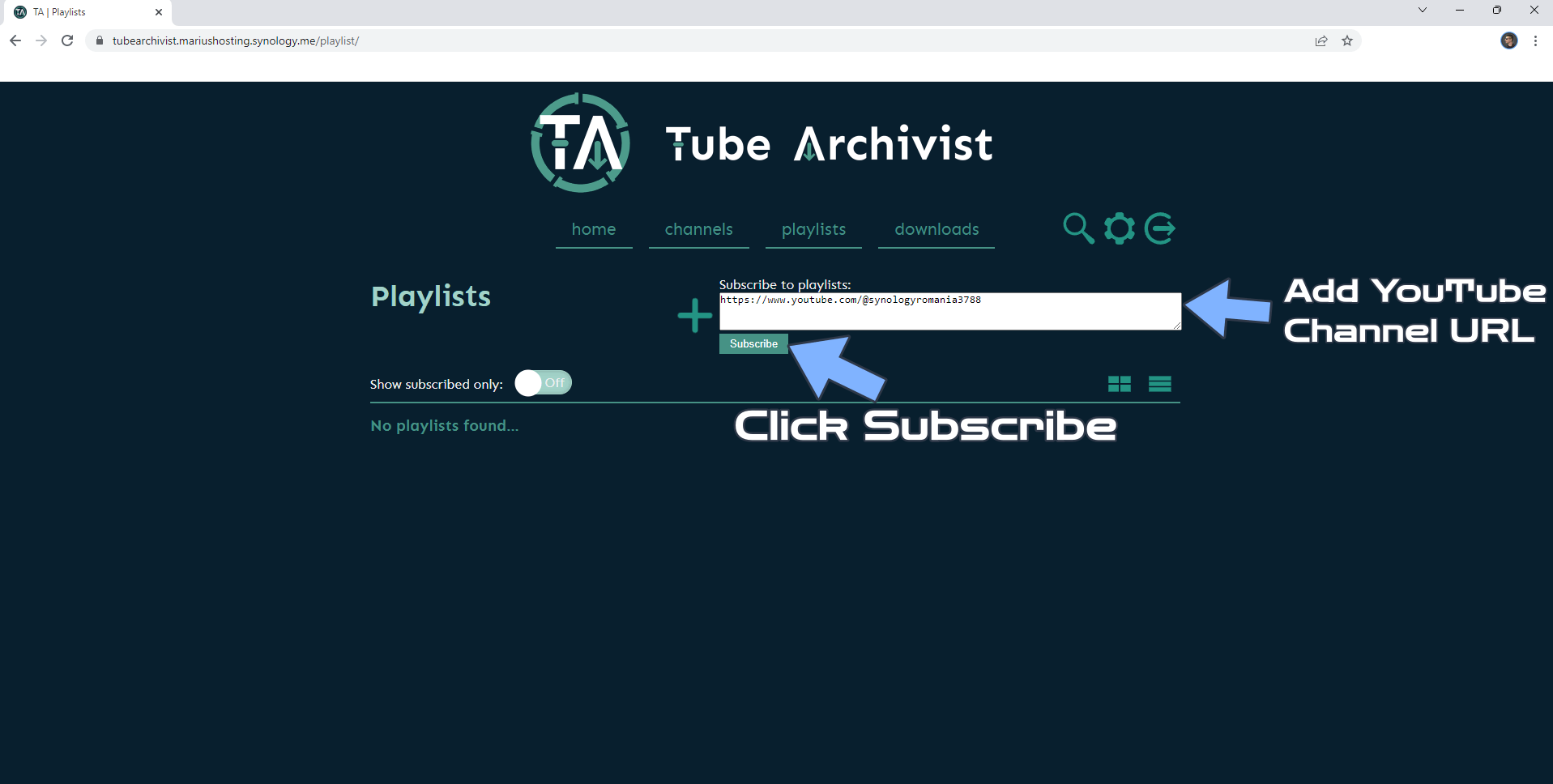
STEP 26
Click Downloads. Follow the instructions in the image below.
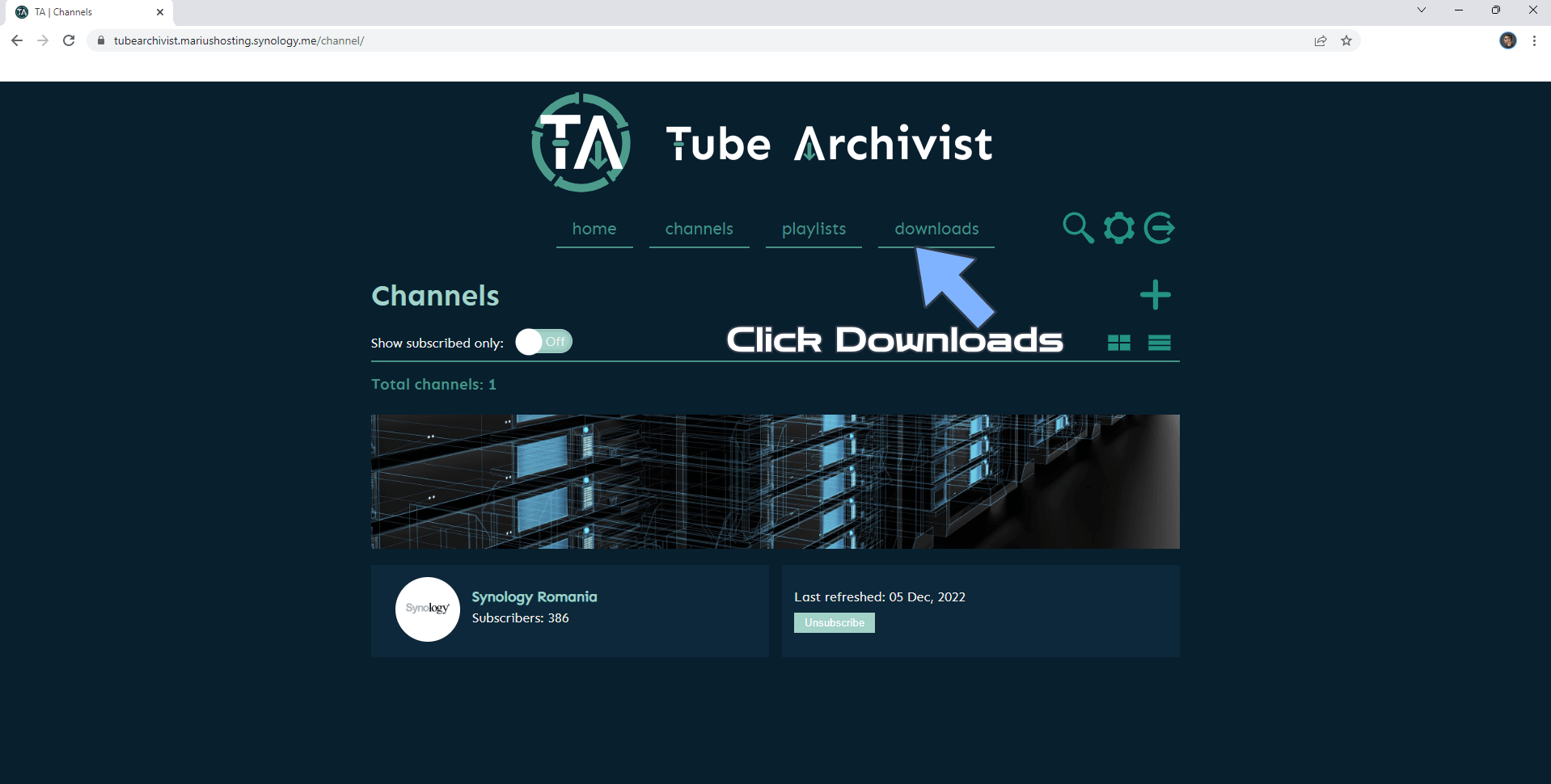
STEP 27
Click Rescan subscriptions. Wait until all the videos in the channel are in queue. Follow the instructions in the image below.

STEP 28
Once all the videos in the queue are ready, click Download now to download your favorite video. Follow the instructions in the image below.

STEP 29
Once the video is downloaded, click Play to watch it. Follow the instructions in the image below.

Your video is ready to watch.
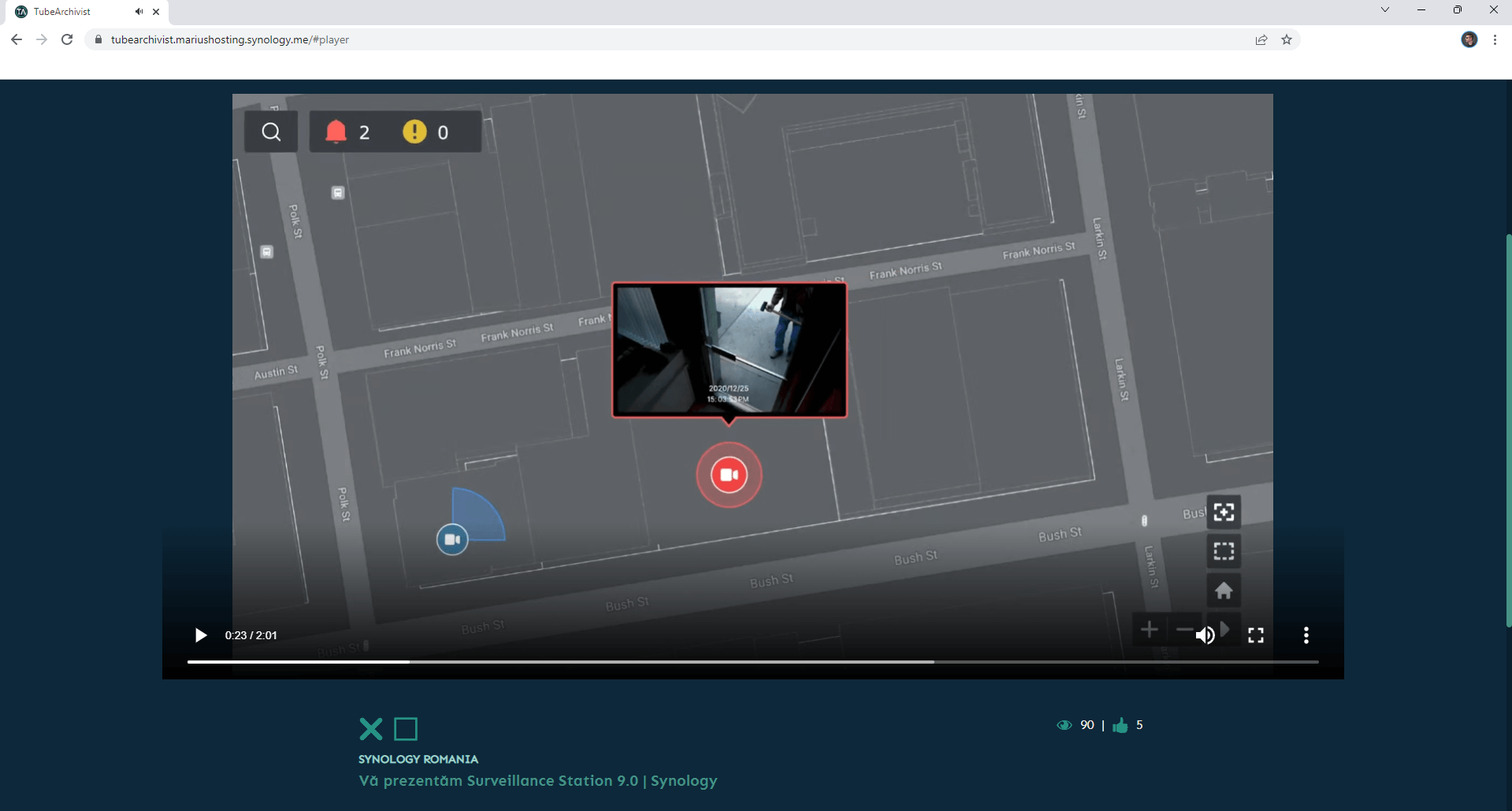
Enjoy Tube Archivist!
If you encounter issues by using this container, make sure to check out the Common Docker issues article.
Note: All your downloaded videos will be saved in the media folder that you have previously create at STEP 11.
Note: Find out how to update the Tube Archivist container with the latest image.
Note: How to Back Up Docker Containers on your Synology NAS.
Note: Can I run Docker on my Synology NAS? See the supported models.
Note: How to Free Disk Space on Your NAS if You Run Docker.
Note: How to Schedule Start & Stop For Docker Containers.
Note: How to Activate Email Notifications.
Note: How to Add Access Control Profile on Your NAS.
Note: How to Change Docker Containers Restart Policy.
Note: How to Use Docker Containers With VPN.
Note: Convert Docker Run Into Docker Compose.
Note: How to Clean Docker.
Note: How to Clean Docker Automatically.
Note: Best Practices When Using Docker and DDNS.
Note: Some Docker Containers Need WebSocket.
Note: Find out the Best NAS Models For Docker.
Note: Activate Gmail SMTP For Docker Containers.
This post was updated on Thursday / August 15th, 2024 at 5:22 PM

